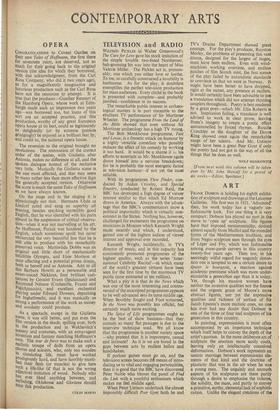ART
FRANK DOBSON is holding his eighth exhibi- tion of sculpture and drawings at the Leicester Galleries. His first was in 1921. 'Advanced' then, his work today has a vaguely un- fashionable look. For one thing it is very compact: Dobson has played no part in the move to 'open up' sculpture. His figures have that imposed monumentality, derived almost equally from Maillol and the rounded forms of the Mediterranean tradition, and from Negro sculpture seen through the eyes of Leger and Fry, which was fashionable among avant-garde carvers in this country twenty-five years ago. Then too, in his seemingly wilful regard for ungainly distor- tion one is tempted to see a certain desire to epater le bourgeois, a reaction against academic prettiness which was more under- standable a generation ago than it is today. 'Yet, though his massive women have neither the inventive qualities nor the finesse and the organic grace of Moore's more abstract figures, nor yet the expressive qualities and richness of surface of Sir Jacob Epstein's more realistic ones, no one has ever had any doubt that Dobson is one of the three or four real sculptors of his generation in this country.
In painting, expressionism is most often accompanied by an impetuous technique which itself helps to convey the depth of the artist's passion. In the more deliberate art of sculpture the emotion more easily cools, leaving only an intellectually conceived deformation. Dobson's work represents an uneasy marriage between expressionist ele- ments of that kind and the doctrine of plasticity that was in the air when he was a young man. The ungainly and uncouth aspects of his sculptures are there partly through a desire to emphasise the volume, the solidity, the mass, and partly to convey a primitive, earthy, elemental lack of sophisti- cation. Unlike the elegant creations of the mannerist painter, a rococo sculptor like Gfinther, or for that matter the fashion artist of today, the typical Dobson woman is low-built. She has a greatly extended midriff between navel and breasts, a big head, heavy limbs, short thighs, and probably her feet turn in. It is in his largest works, like The Fount (seen some years back at the Royal Academy) that this gracelessness is most apparent. On this scale, too, Dobson's resolute rejection of any subtlety of surface modelling is apt to, result in a certain obviousness and emptiness. His talent shows most clearly when least forced—in the calm simplicity of drawings like Nos. 28 and 32 (both incidentally back views) and in smaller studies for sculpture like Nos. 53, 55, 63 and 75. Indeed, in this his first show for nine years, there are many indications of a new complexity and a new sensitivity in Dobson's outlook, which can only serve to Increase the respect in which he is held.
Only two British artists in this century, dying young, gave birth to legends. Kit Wood was one, Gaudier-Brzeska was tIr other. The one was as gentle as the other was savage. Gaudier-Brzeska burned with unresolved desires. At the Beaux Arts Gallery, where we saw an exhibition of his sculpture a year or two ago, there is now an excellent collection of his drawings—nervous, urgent, free as Matisse but less. oriental and more muscular; purely calligraphic yet nevertheless filled with a sculptor's sense of interwedging forms.
Also to be seen here are paintings by Denis Wirth-Miller, who has taken a long, strong pull at a pipe of Francis Bacon hashish. Like his master's, his paintings are glazed, and through the glass darkly, on the same unprimed canvas, slinks, scuttles and runs that same dog which we have noted in the works, not only of Mr. Bacon but of Mr. Sutherland also. It is an ambiguous hound, carefully decked out in some rather tricky techniques, so that at close range it seems now to have been made of coils of barbed wire, now to be seen through the ripple-glass of the bathroom window. It Wes us the authentic moment of unease that comes when we do suddenly sense the dark, moving shape of some undefined animal moving towards us through some such glass barrier. But after that there is rather the same emptiness that a framed photograph possesses. M. H. MIDDLETON



































































 Previous page
Previous page